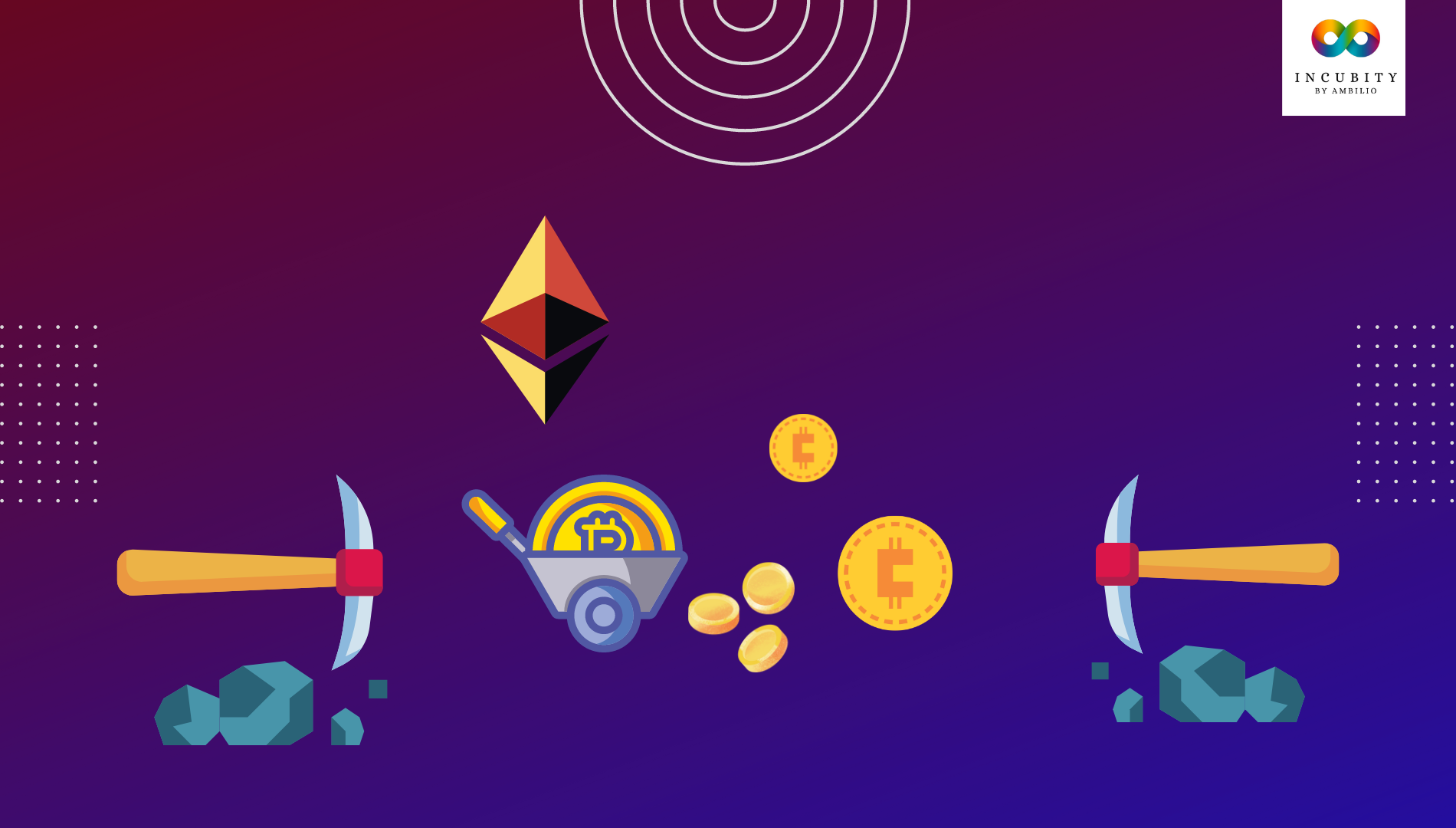Blockchain is the underlying technology behind cryptocurrencies like Bitcoin and Ethereum. It has the potential to be used in a wide range of industries beyond just finance. One of the key concepts used in this technology is mining. In this article, we will explore the process of blockchain mining, the different types of mining, the rewards offered to miners, and how to set up a mining operation. We will also look at a hands-on code example for mining in a blockchain system Python.
The Process of Blockchain Mining and Its Types
Mining is the process of adding new blocks to a blockchain network. Miners, who are individuals or groups of individuals, use specialized software and hardware to validate and process transactions on the network. This process is done through the use of consensus mechanisms, which are algorithms that ensure the integrity and security of the blockchain.
The most common consensus mechanism used in blockchain mining is proof-of-work (PoW). In PoW, miners compete against each other to solve a complex mathematical problem, known as a hash. The first miner to solve the hash is able to add the next block to the blockchain and is rewarded with a certain number of tokens or coins. The complex mathematical problem is designed to be difficult to solve, but easy to verify, which helps ensure the security of the network.
Once a block is added to the blockchain, it is broadcasted to the rest of the network for validation. Other miners will then check the transactions in the block to ensure that they are valid and that the miner who added the block followed the consensus rules.
The process of mining is not only about solving the mathematical problem but also about verifying the transactions, the miners are incentivized to act honestly and validate the transactions, once the block is mined, it becomes a permanent part of the blockchain and the transactions within it are considered to be confirmed.
In addition to proof-of-work (PoW), other consensus mechanisms are also being developed and implemented in different blockchain networks, such as proof-of-stake (PoS). Proof-of-stake is a more energy-efficient alternative to proof-of-work, as it does not require miners to solve complex mathematical problems to add a block to the blockchain.
In PoS, instead of using computational power to validate transactions, the miner’s ability to validate transactions is determined by the amount of coins or tokens they hold, also known as their “stake” in the network. This means that the more coins a miner holds, the more likely they are to be chosen to validate transactions and add a block to the blockchain. This process is known as “forging” or “minting” blocks.
In PoS, the miner is chosen randomly, and the probability of being chosen is proportional to the miner’s stake in the network, this mechanism reduces the competition and the energy consumption needed to validate transactions and add a block to the blockchain, as well it makes it more difficult for a miner to control a significant portion of the network, this is known as the “Nothing at Stake” problem.
Another advantage of PoS is that it allows for a more decentralized network, as it does not require a large investment in specialized mining equipment. With PoS, anyone with a significant amount of coins or tokens can become a validator, provided they keep their wallet open and connected to the network.
PoW Vs PoS in Blockchain Mining
PoW and PoS are the most famous mining mechanisms. They have both advantages and disadvantages, and the choice of which one to use depends on the specific requirements of the blockchain network. We can sum this paragraph up with a table, comparing PoW and PoS:
| Proof-of-Work | Proof-of-Stake |
| Miners must solve complex mathematical problems in order to add a block to the blockchain. The first miner to solve the problem is rewarded with a certain number of coins or tokens. | Miners are chosen randomly based on the amount of coins or tokens they hold, also known as their “stake” in the network. This process is known as “forging” or “minting” blocks. |
| It has a higher potential for centralization due to the high cost of the mining equipment. | It allows for a more decentralized network, as it does not require a large investment in specialized mining equipment. |
| It is energy-intensive as it requires significant computational power to solve the mathematical problem. | It is energy-efficient as it doesn’t require significant computational power. |
| It is a more secure mechanism as it’s difficult to control a significant portion of the network. | It’s less secure than PoW since an attacker with a large amount of coins can control a significant portion of the network, known as the “Nothing at Stake” problem. |
| It’s more susceptible to 51% of attacks | It’s less susceptible to 51% of attacks |
DPoS and PoA in Blockchain Mining
A newer type of blockchain mining is called “Delegated Proof-of-Stake (DPoS)” which is used in networks such as Lisk, Ark, and Steem. In DPoS, token holders elect a group of validators to validate transactions and add blocks to the blockchain. This mechanism allows for a high level of scalability and fast confirmation times but also, but it’s more centralized.
Another emerging consensus mechanism is “Proof of Authority (PoA)” which is used in private and consortium chains, where the validators are known and pre-approved, this mechanism is more efficient than PoW and PoS, but it’s less decentralized as it requires a central authority to approve the validators.
Finally, new consensus mechanisms are constantly being developed and implemented in different blockchain networks, and each has its unique characteristics, benefits, and drawbacks.
Blockchain Mining Rewards
When a miner successfully adds a block to the blockchain, they are typically rewarded with a certain number of coins or tokens. The amount of the reward varies depending on the blockchain network. For example, in the Bitcoin network, the current block reward is 6.25 BTC. These rewards are designed to incentivize miners to participate in the network and help secure it.
In addition to block rewards, miners may also earn transaction fees. These are fees paid by users to have their transactions included in a block. The miner who adds the block to the blockchain receives these transaction fees as an additional reward.
It’s also worth noting that there are other types of rewards, such as “staking rewards” in PoS networks, where the miner earns a reward for holding a certain amount of coins or tokens, also known as staking, for some time.
While mining rewards can be a significant source of income for miners, there are also risks and challenges associated with them. The value of the coins or tokens used as rewards can be highly volatile, making it difficult for miners to predict their income. Additionally, as the mining difficulty increases and the number of miners increases, the rewards may decrease, which could make mining less profitable.
Overall, mining rewards are an important aspect of blockchain networks, as they incentivize miners to participate in the network and help secure it. However, miners need to understand the potential risks and challenges associated with mining rewards in order to make informed decisions about whether to participate in a particular blockchain network.
Setting Up a Mining Operation
Here is a step-by-step guide to setting up a mining operation:
Step 1: Choose a blockchain network: The first step in setting up a mining operation is to choose a blockchain network to mine on. Some popular networks include Bitcoin, Ethereum, and Litecoin. It’s important to research and compare the different networks in terms of mining difficulty, rewards, and overall network health.
Step 2: Get the necessary hardware: Depending on the network, you will need specialized hardware, such as ASIC miners for Bitcoin and graphics cards for Ethereum, to mine efficiently. It would help if you also considered the hardware’s energy consumption and the costs associated with it.
Step 3: Download and install mining software: Once you have the necessary hardware, you will need to download and install mining software that is compatible with your hardware and the blockchain network you have chosen. Some popular mining software options include CGMiner, BFGMiner, and Ethminer.
Step 4: Create a wallet: Before you start mining, you will need to create a wallet to store the coins or tokens you earn. Make sure to choose a wallet that is compatible with the blockchain network you have chosen.
Step 5: Join a mining pool: Joining a mining pool allows you to combine your computing power with other miners to increase your chances of solving a mathematical problem and earning rewards. Make sure to research and compare different mining pools in terms of fees, rewards, and overall network health.
Step 6: Start mining: Once you have completed these steps, you can start mining by running the mining software and connecting it to the mining pool.
Setting up a mining operation can be a complex and time-consuming process. It requires a significant investment in specialized hardware and software and ongoing costs such as electricity consumption. Miners should carefully research and consider these costs before setting up an operation and be aware of the volatility of cryptocurrency prices.
Blockchain Mining in Python
In this section, we will use the python code we created in this article (Getting started with Blockchain and building a simple system in Python) and update it, to imitate the process of mining.
| import hashlib import time class Block: def __init__(self, name, data, previous_hash, nonce, difficulty): self.name = name #name of the block self.data = data #data stored in the block self.previous_hash = previous_hash #hash of the previous block in the chain self.nonce = nonce self.difficulty = difficulty self.mining_time = 0 self.hash = self.mine_block() def calculate_hash(self): sha = hashlib.sha256() sha.update((self.name + self.data + self.previous_hash + str(self.nonce)).encode(‘utf-8’)) return sha.hexdigest() def mine_block(self): “”” Function that mines the block by incrementing the nonce value until the hash of the block starts with a certain number of leading zeros (difficulty) “”” target = ‘0’*self.difficulty self.mining_time = time.time() while self.calculate_hash()[:self.difficulty] != target: self.nonce += 1 self.hash = self.calculate_hash() self.mining_time = time.time() – self.mining_time print(“Block mined: “ + self.hash) return self.hash class Blockchain: def __init__(self): self.chain = [self.create_genesis_block()] def create_genesis_block(self): return Block(“Genesis Block”, “”, “0”, 0, 3) def add_block(self, new_block): new_block.previous_hash = self.chain[-1].hash new_block.difficulty = self.chain[-1].difficulty + 1 self.chain.append(new_block) def display_blockchain(self): for block in self.chain: print(“Name: “, block.name) print(“Data: “, block.data) print(“Previous Hash: “, block.previous_hash) print(“Hash: “, block.hash) print(“Nonce: “, block.nonce) print(“Difficulty: “, block.difficulty) print(“Mining Time: “, block.mining_time) print() def display_block(self, block_index): block = self.chain[block_index] print(“Name: “, block.name) print(“Data: “, block.data) print(“Previous Hash: “, block.previous_hash) print(“Hash: “, block.hash) print(“Nonce: “, block.nonce) print(“Difficulty: “, block.difficulty) print(“Mining Time: “, block.mining_time) # Initialize blockchain blockchain = Blockchain() # Add blocks to the blockchain blockchain.add_block(Block(“Block 1”, “Block 1 Data”, blockchain.chain[-1].hash, 0, blockchain.chain[-1].difficulty+1)) blockchain.add_block(Block(“Block 2”, “Block 2 Data”, blockchain.chain[-1].hash, 0, blockchain.chain[-1].difficulty+1)) blockchain.add_block(Block(“Block 3”, “Block 3 Data”, blockchain.chain[-1].hash, 0, blockchain.chain[-1].difficulty+1)) print(“—————“) #Display the entire blockchain blockchain.display_blockchain() |
Block mined: 000b62613dc20e55298e90a3053da0517c6617625d34711d22b5f125e44ac5c9
Block mined: 0000485a714e222e5061eda9a1ed1d965ccbb30a66f1d393e2cb307a7f7642d5
Block mined: 000006ddafb05bc1e72bed26a5b8a664ae482a89f8a2405595af671e3c68df46
Block mined: 00000098e0df3ad15337ab0d7011e034cd5fe2da242d461c424d0bcd3dab6682
—————
Name: Genesis Block
Data:
Previous Hash: 0
Hash: 000b62613dc20e55298e90a3053da0517c6617625d34711d22b5f125e44ac5c9
Nonce: 3521
Difficulty: 3
Mining Time: 0.007765054702758789
Name: Block 1
Data: Block 1 Data
Previous Hash: 000b62613dc20e55298e90a3053da0517c6617625d34711d22b5f125e44ac5c9
Hash: 0000485a714e222e5061eda9a1ed1d965ccbb30a66f1d393e2cb307a7f7642d5
Nonce: 138911
Difficulty: 4
Mining Time: 0.33255553245544434
Name: Block 2
Data: Block 2 Data
Previous Hash: 0000485a714e222e5061eda9a1ed1d965ccbb30a66f1d393e2cb307a7f7642d5
Hash: 000006ddafb05bc1e72bed26a5b8a664ae482a89f8a2405595af671e3c68df46
Nonce: 416090
Difficulty: 5
Mining Time: 0.9672214984893799
Name: Block 3
Data: Block 3 Data
Previous Hash: 000006ddafb05bc1e72bed26a5b8a664ae482a89f8a2405595af671e3c68df46
Hash: 00000098e0df3ad15337ab0d7011e034cd5fe2da242d461c424d0bcd3dab6682
Nonce: 9090111
Difficulty: 6
Mining Time: 23.478293657302856
Understanding the Code
The mining process in this code is the process of creating new blocks in the blockchain. The mining process involves finding a solution to a mathematical problem, which in this case is finding a nonce value that results in a hash of the block that meets the difficulty requirement.
The difficulty is a parameter that sets the number of leading zeros that the hash of the block should have. It is defined when creating a new block and can be increased with every new block added to the blockchain. The higher the difficulty, the harder it is to find a solution to the mathematical problem, and the longer it takes to mine a block. (You can check the output. While the difficulty is increasing, the time consumed to find a hash that meets the requirements is increasing as well)
A nonce is a random number included in the calculation of the block’s hash. By incrementing the nonce value and calculating the hash of the block again, the miner is effectively trying different inputs to the hash function in an attempt to find one that meets the difficulty requirement (in this case, a certain number of leading zeros in the hash).
Once a miner finds a solution, it can then broadcast it to the network for validation, and if it is accepted, the block is added to the blockchain. The mining time of the block is also recorded as the time between the start of the mining process and the time the solution is found.
In this code, the mining process is a simplified version of the real-world process, and it doesn’t include the concept of multiple miners competing to find the solution. Still, it illustrates the basic idea of the mining process in a blockchain, which is the process of finding a solution to a mathematical problem that meets certain requirements.
Now, Let’s explain the code, focusing on the new variables and features. The code defines two classes: ‘Block’ and ‘Blockchain’.
The ‘Block’ class has the following attributes:
- name: The block’s name.
- data: The data stored in the block.
- previous_hash: The hash of the previous block in the chain.
- nonce: A number that is used in the mining process.
- difficulty: The number of leading zeros that the hash of the block should have.
- mining_time: The time it took to mine the block.
- hash: The hash of the block.
In our updated code, the ‘Block’ class contains two methods instead of one. The two methods are
- ‘calculate_hash()’: This function calculates the hash of the block by concatenating the block’s name, data, previous_hash, and nonce and passing it through a sha256 hash function.
- ‘mine_block()’: This is a new method. It mines the block by incrementing the nonce value until the hash of the block starts with a certain number of leading zeros (difficulty). This function starts by initializing the target variable, which is a string of ‘0’ repeated as many times as the difficulty. It then starts a loop, where it calls the ‘calculate_hash()’ method on the current block, and compares the returned hash with the target. If it does not match, the nonce is incremented by one and the process is repeated until a match is found.
The ‘Blockchain’ class has one attribute, chain, which is a list of blocks representing the blockchain.
The class has the following methods:
- ‘create_genesis_block()’: This function creates the first block in the blockchain, also known as the genesis block.
- ‘add_block()’: This function adds a new block to the blockchain by setting the previous_hash of the new block to the hash of the current last block and incrementing the difficulty.
- ‘display_blockchain()’: This function displays all the blocks in the blockchain.
- ‘display_block()’: This function displays a specific block in the blockchain based on the block index.
The code then creates an instance of the Blockchain class called ‘blockchain’ and adds three blocks to it with the ‘add_block()’ function. Finally, it displays the entire blockchain using the ‘display_blockchain()’ function.
Final Words
In conclusion, blockchain mining is a complex process that requires a significant investment in specialized hardware and software, as well as ongoing costs such as electricity consumption. The process of mining involves solving complex mathematical problems in order to add new blocks to the blockchain and earn rewards.
Two of the most common consensus mechanisms used in blockchain mining are proof-of-work (PoW) and proof-of-stake (PoS). Each has its own unique characteristics, benefits, and drawbacks, and the choice of which one to use depends on the specific requirements of the blockchain network.
In this guide, we discussed different types of blockchain mining and provided a step-by-step guide on setting up a mining operation. We also provided a sample code for setting up a mining operation on a blockchain we created using Python.
It’s important to keep in mind that blockchain mining can be a complex and time-consuming process, and it requires a significant investment in specialized hardware and software, as well as ongoing costs such as electricity consumption. Miners should carefully research and consider these costs before setting up an operation and be aware of the volatility of cryptocurrency prices.



